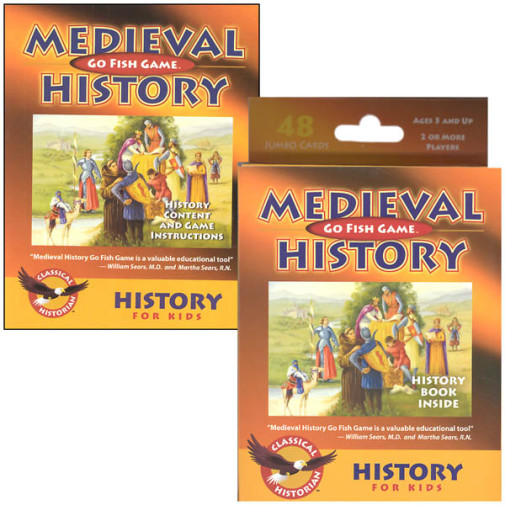We use cookies to make your experience better. To comply with the new e-Privacy directive, we need to ask for your consent to set the cookies. Learn more.
Medieval History Go Fish Game with History Book
- 48 game cards and 7 different games to play; different learning skills practiced with each game
- A perfect addition to turn any Medieval History study into a multi-sensory experience
- Great visual aid for classic art and locations around the world!
The deck includes 12 category cards with 4 cards per category. The categories are Architecture, Paintings, Aztecs/Incas/Maya, Technology, Religion, Warriors, Royal Power, Warfare, People, Arabia, Castles, and Famous Medieval Leaders. The booklet contains a paragraph on the historical content of each card, game instructions, and teaching suggestions. Students learn quick facts and historical associations with every card. ~Rebecca
Four Fun Games that teach history!
Go Fish GamePlayers try to collect all four-of-a-kind cards from the following categories. The player who captures most sets wins.- Architecture
- Paintings
- Aztecs, Incas, Mayas
- Technology
- Religion
- Warriors
- Royal Power
- Warfare
- People
- Arabia
- Castles
- Famous Medieval Leaders
Chronology
Following the Answer Key instructions, shuffle the cards necessary for the chronology game. When one player signals, the other player assembles all cards in chronological order, as fast as he can. The fastest time wins!
Collect the Cards
Players use historical facts (hints) to try and guess the image on the card. If a player guesses correctly, he wins the card.
Geography
Place these four card at the top of the playing field: Castle, Quetzalcoatl Temple, Samurai, and Caravan in the Sahra Desert. Shuffle the other cards. When one player signals, the other player assembles all cards under the correct card, based on the continent each card represents, as fast as he can. The fastest time wins! Answer key provided.
The included booklet provides the teacher with a wide variety of games to teach Medieval history to kids in a one-on-one setting or in a family with kids of different ages. It also includes history explanations for all 48 Medieval History Go Fish Cards. It is meant to be used with the Classical Historian Medieval Go Fish Game.
Play a game of educational go-fish—you'll walk away knowing more about your world! Just like Go Fish or Top Trumps, the game's goal is to collect the 4 cards in a series! Each time period game highlights 12 different themes to learn about: significant thinkers, pioneers, explorers, countries, and landmarks with full-color photos and illustrations. You might match 4 major world waterfalls or 4 Greek mythological figures. Each set of 48 cards is packaged for easy travel, and includes a small instructional booklet that suggests some additional games and also highlights information about each card. Play time is generally ten to twenty minutes; 2-6 players.







To compliment our Medieval history morning basket.
Our morning basket is themed for the Middle Ages this year, so this game will be the perfect addition to supplement their learning in a fun way. Just a bit of fun that we can do as a family to extend…
My son is a historian
Medieval History focus for school this year